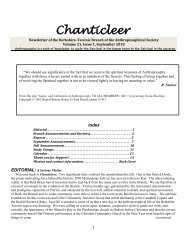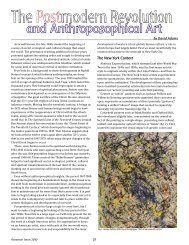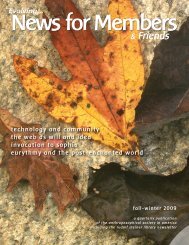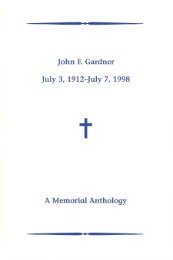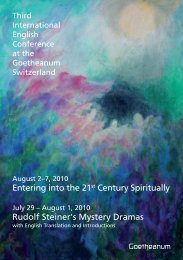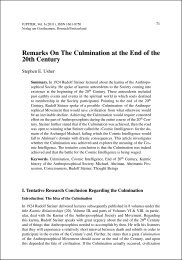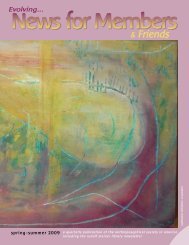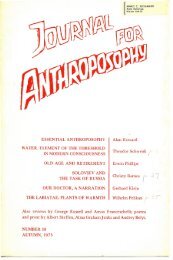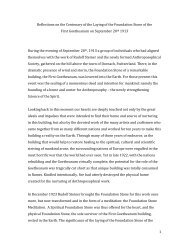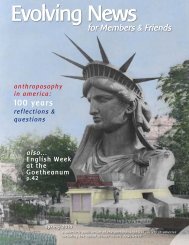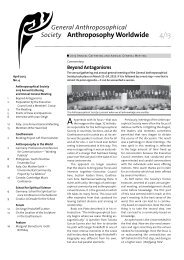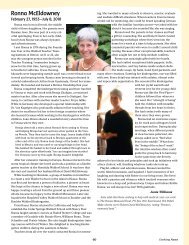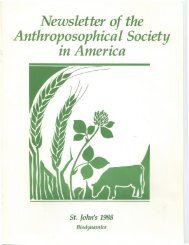Rudolf Steiner's Vision for the Future - Anthroposophical Society in ...
Rudolf Steiner's Vision for the Future - Anthroposophical Society in ...
Rudolf Steiner's Vision for the Future - Anthroposophical Society in ...
Create successful ePaper yourself
Turn your PDF publications into a flip-book with our unique Google optimized e-Paper software.
Library Annotations<br />
European arts community is tak<strong>in</strong>g notice.<br />
From <strong>the</strong> <strong>in</strong>troduction: “It was always Ste<strong>in</strong>er’s<br />
extraord<strong>in</strong>ary way of see<strong>in</strong>g objects and nonobjects<br />
that led to susta<strong>in</strong>able re<strong>for</strong>m projects<br />
<strong>in</strong> such fields as agriculture, education and<br />
medic<strong>in</strong>e. This book exam<strong>in</strong>es <strong>for</strong> <strong>the</strong> first time<br />
anthroposophist thought as reflected <strong>in</strong> contemporary<br />
art and to what extent its <strong>in</strong>tegral<br />
concepts and aes<strong>the</strong>tic ideas are realized <strong>in</strong><br />
<strong>the</strong> visual arts.”<br />
At <strong>the</strong> Dawn of a New Consciousness: Art,<br />
Philosophy and <strong>the</strong> Birth of <strong>the</strong> Modern<br />
World, Bernard Nesfield-Cookson, Temple<br />
Lodge, 2010, 160 pgs.<br />
In this book, illustrated with sixteen pages<br />
of color plates, <strong>the</strong> author illum<strong>in</strong>ates <strong>the</strong> concept<br />
of <strong>the</strong> consciousness soul, show<strong>in</strong>g how<br />
it is reflected <strong>in</strong> fifteenth-century Florent<strong>in</strong>e<br />
pa<strong>in</strong>t<strong>in</strong>g, sculpture, and architecture, as well<br />
as <strong>in</strong> <strong>the</strong> impulses issu<strong>in</strong>g from Plato’s Academy<br />
of A<strong>the</strong>ns.<br />
Anthroposophy—Biography<br />
Tell Me <strong>the</strong> Names of Your Friends and I<br />
Will Tell You Who You Are, Lee Sturgeon Day,<br />
dog ear publish<strong>in</strong>g, 2010, 160 pgs.<br />
A m<strong>in</strong>or surgery damaged <strong>the</strong> author’s<br />
vocal cords, result<strong>in</strong>g <strong>in</strong> <strong>the</strong> total loss of her<br />
voice. Tell Me <strong>the</strong> Names of Your Friends and<br />
I Will Tell You Who You Are is an account of this<br />
experience, related through her shar<strong>in</strong>g of her<br />
email correspondence with her friends. Her<br />
<strong>the</strong>me: our lives are created through our<br />
relationships, and we can see how our lives<br />
are shaped and guided by <strong>the</strong> people who<br />
enter <strong>the</strong>m. By <strong>the</strong> author of A Slice of Life.<br />
We Came…Biographic Sketches of <strong>the</strong><br />
Twenty-Five Participants of <strong>the</strong> First<br />
Camphill Sem<strong>in</strong>ar <strong>in</strong> Curative Education<br />
1949 – 1951, edited by Erika Nauck, Camphill<br />
[Private publication], 2009, 124 pgs.<br />
The editor of this collection, one of <strong>the</strong><br />
sem<strong>in</strong>ar participants herself, was <strong>in</strong>spired to<br />
compile <strong>the</strong>se sketches when she read <strong>the</strong> The<br />
94 • be<strong>in</strong>g human<br />
Builders of Camphill: Lives and Dest<strong>in</strong>ies of <strong>the</strong><br />
Founders (2004; also available from <strong>the</strong> library).<br />
Her fellow sem<strong>in</strong>arists, called “brickies,” cont<strong>in</strong>ued<br />
<strong>the</strong> work of <strong>the</strong> founders. Fifteen of <strong>the</strong><br />
25 participants cont<strong>in</strong>ued to live and work <strong>in</strong><br />
Camphill from <strong>the</strong>ir completion of <strong>the</strong> sem<strong>in</strong>ar<br />
to <strong>the</strong> present. Their fasc<strong>in</strong>at<strong>in</strong>g biographies<br />
illustrate “how miraculously human dest<strong>in</strong>ies<br />
are guided to a certa<strong>in</strong> place at an important<br />
moment <strong>in</strong> life—often despite many obstacles.”<br />
Letters from Florence: Observations on <strong>the</strong><br />
Inner Art of Travel, Marie-Laure Valandro,<br />
L<strong>in</strong>disfarne Books, 2010, 110 pgs.<br />
Wander<strong>in</strong>g <strong>the</strong> streets, ca<strong>the</strong>drals, and<br />
museums of Florence and <strong>the</strong> surround<strong>in</strong>g<br />
towns of Tuscany, <strong>the</strong> author shares her<br />
impressions of <strong>the</strong> Florent<strong>in</strong>e pa<strong>in</strong>ters, philosophers,<br />
poets, and architecture of bygone eras.<br />
By <strong>the</strong> author of Cam<strong>in</strong>o Walk.<br />
Anthroposophy—Child Development<br />
Enlightened Parent<strong>in</strong>g: What Every Child<br />
Wishes <strong>for</strong> & What Every Parent Wants to<br />
Give, Ronna McEldowney, Dandelion Books,<br />
2008, 239 pgs.<br />
The author, who crossed <strong>the</strong> threshold <strong>in</strong><br />
July, was a Waldorf k<strong>in</strong>dergarten teacher <strong>for</strong><br />
over 30 years and was revered around <strong>the</strong><br />
world. Her creativity and open heart are<br />
evident throughout this book, which encourages<br />
parents to see <strong>the</strong>ir role <strong>in</strong> a spiritual light<br />
and to proceed with humor and courage. Her<br />
<strong>in</strong>sights and compassion will provide welcome<br />
guidance.<br />
Anthroposophy—Child Development—<br />
Temperaments<br />
The Temperaments and <strong>the</strong> Adult-Child<br />
Relationship, Kristie Karima Burns, Bearth<br />
Publish<strong>in</strong>g, 2010, 239 pgs.<br />
A homeopath and herbalist, <strong>the</strong> author<br />
has also worked as a Waldorf early-childhood<br />
educator. Her work on <strong>the</strong> temperaments is<br />
based on that of <strong>Rudolf</strong> Ste<strong>in</strong>er, as well as of<br />
Avicenna (981-1037), <strong>the</strong> <strong>for</strong>emost physician<br />
and philosopher of his time. Her detailed<br />
discussions of each temperament <strong>in</strong>clude vivid<br />
examples. The author describes <strong>the</strong> various<br />
adult-child relationships among <strong>the</strong> temperaments<br />
(melancholic adult/sangu<strong>in</strong>e child;<br />
sangu<strong>in</strong>e adult/choleric child, etc.), and offers<br />
helpful suggestions <strong>for</strong> how adults (with<br />
specific tips <strong>for</strong> parents and teachers) can<br />
work with <strong>the</strong>ir own temperament to best meet<br />
<strong>the</strong> children <strong>in</strong> <strong>the</strong>ir care.<br />
Anthroposophy—Medic<strong>in</strong>e<br />
The Twelve Nurs<strong>in</strong>g Gestures <strong>in</strong> Relation to<br />
<strong>the</strong> Zodiac: A Nurs<strong>in</strong>g Model, Rolf He<strong>in</strong>e,<br />
trans. Anna Meuss, Anthroposophic Nurs<strong>in</strong>g<br />
Assoc, 2008, 44 pgs.<br />
Rolf He<strong>in</strong>e, coord<strong>in</strong>ator of <strong>the</strong> International<br />
Forum <strong>for</strong> Anthroposophic Nurs<strong>in</strong>g, gave <strong>the</strong><br />
lectures presented here at <strong>the</strong> Vidarkl<strong>in</strong>iken <strong>in</strong><br />
Jarna, Sweden, <strong>in</strong> October 2005. He<strong>in</strong>e states:<br />
“There are two opposite poles to nurs<strong>in</strong>g: <strong>the</strong><br />
nurs<strong>in</strong>g activity and <strong>the</strong> <strong>in</strong>ner attitude or <strong>the</strong><br />
nurs<strong>in</strong>g ethos. The important question is: how<br />
can <strong>in</strong>ner attitude become activity? How can<br />
someth<strong>in</strong>g which I <strong>in</strong>wardly strive to achieve<br />
with <strong>the</strong> patient become visible activity?... Between<br />
action and attitude lies <strong>the</strong> gesture. The<br />
gesture is <strong>in</strong> <strong>the</strong> middle. A <strong>the</strong>rapeutic, nurs<strong>in</strong>g<br />
gesture leaves <strong>the</strong> patient free.”<br />
Healthy Body, Healthy Bra<strong>in</strong>: Alzheimer's<br />
and Dementia Prevention and Care, Jenny<br />
Lewis, Floris, 2010, 64 pgs.<br />
This book is <strong>the</strong> result of <strong>the</strong> author’s<br />
research and experience as a caregiver <strong>for</strong> her<br />
mo<strong>the</strong>r. Lewis discusses <strong>the</strong> importance of<br />
valu<strong>in</strong>g and car<strong>in</strong>g <strong>for</strong> <strong>the</strong> elderly, encourag<strong>in</strong>g<br />
mobility and <strong>in</strong>dependence <strong>for</strong> as long as<br />
possible. She emphasizes prevention of<br />
Alzheimer’s disease and dementia through<br />
nutrition, physical activity, and positivity, and<br />
offers suggestions <strong>for</strong> how to improve <strong>the</strong><br />
health and well-be<strong>in</strong>g of those already suffer<strong>in</strong>g<br />
from <strong>the</strong>se conditions.



